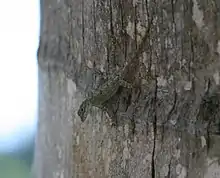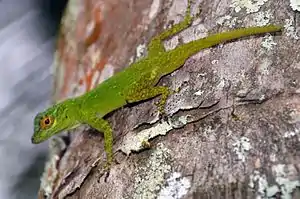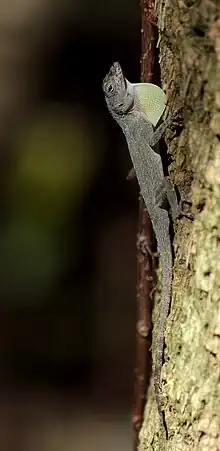Anolis distichus
Anolis distichus, the bark anole, North Caribbean bark anole, or Hispaniolan gracile anole, is a species of anole lizard (US: /əˈnoʊ.li/ ⓘ) native to Hispaniola (both the Dominican Republic and Haiti) and the Bahamas, and introduced to Florida, where it was first recorded in 1946.[2][3][4] It spends most its time on tree trunks. There are several subspecies and it is highly variable in color. Its body ranges from gray-brown to green, and the dewlap is cream-white, over yellow and orange to red. In Florida, most are gray-brown with a cream-white (pale yellow) dewlap, but more greenish individuals with a yellow-edged red dewlap also occur. It is a fairly small anole, reaching up to 12.7 cm (5.0 in) in length.[4][5]
| Anolis distichus | |
|---|---|
 | |
 | |
| Gray-brown and green individuals | |
| Scientific classification | |
| Domain: | Eukaryota |
| Kingdom: | Animalia |
| Phylum: | Chordata |
| Class: | Reptilia |
| Order: | Squamata |
| Suborder: | Iguania |
| Family: | Dactyloidae |
| Genus: | Anolis |
| Species: | A. distichus |
| Binomial name | |
| Anolis distichus | |
| Subspecies | |
|
See text | |
Subspecies


Subspecies listed alphabetically. Some of these may warrant recognition as separate species.[2]
- A. d. distichus Cope, 1861
- A. d. biminiensis Oliver, 1948
- A. d. dapsilis Schwartz, 1968
- A. d. distichoides Rosén 1911
- A. d. floridanus Smith & Mccauley 1948
- A. d. juliae Cochran 1934
- A. d. ocior Schwartz, 1968
- A. d. patruelis Schwartz, 1968
- A. d. sejunctus Schwartz, 1968
- A. d. suppar Schwartz, 1968
- A. d. tostus Schwartz, 1968
References
- Mahler, D.L., Buckner, S. & Reynolds, R.G. 2021. Anolis distichus. The IUCN Red List of Threatened Species 2021: e.T203881A2771971. Downloaded on 04 September 2021.
- Anolis distichus, The Reptile Database
- Anolis distichus, Wildherps
- "Nonnatives - Bark Anole". Florida Fish and Wildlife Conservation Commission. Archived from the original on 15 October 2016. Retrieved 19 March 2018.
- Schwartz, A. (1968). Geographic Variation in Anolis distichus Cope (Lacertilia, Iguanidae) in the Bahama Islands and Hispaniola. Bulletin of the Museum of Comparative Zoology at Harvard College 137: 255-309.
